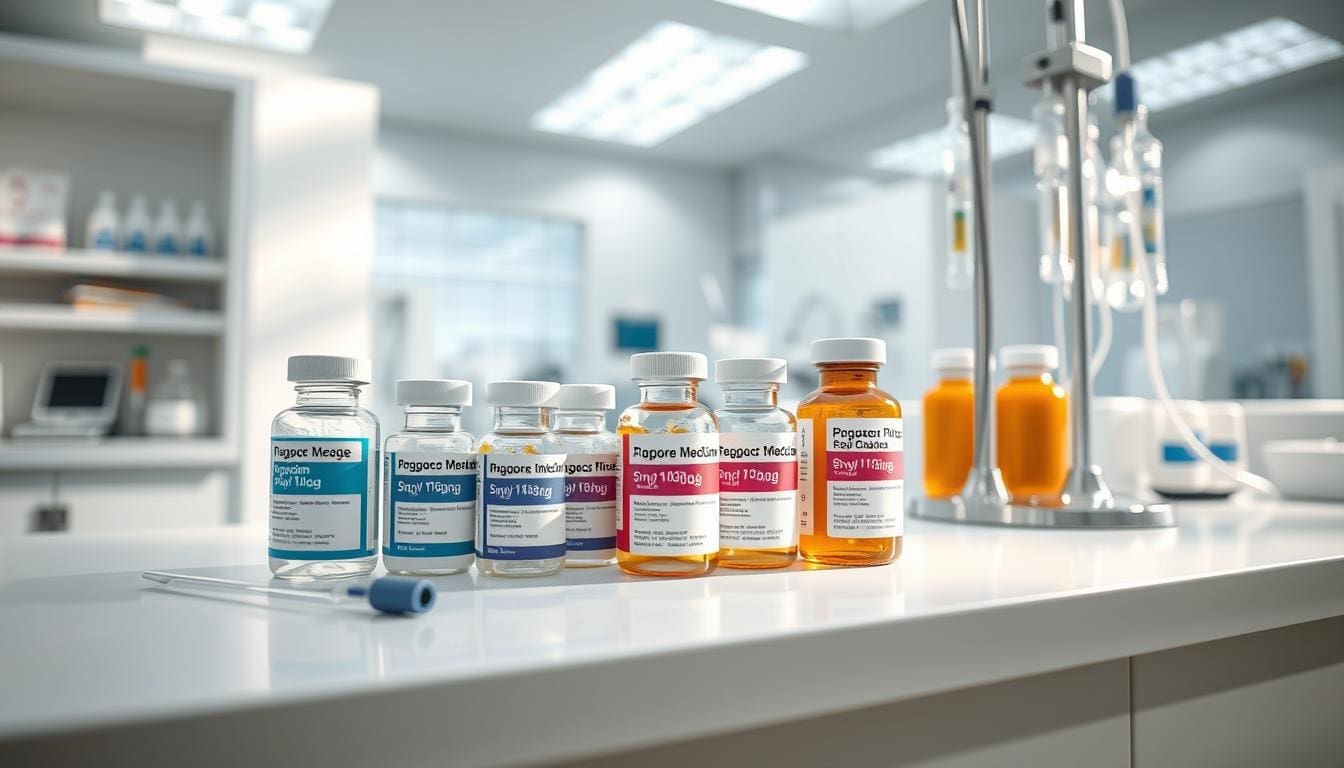Last Updated on November 26, 2025 by Bilal Hasdemir

We are seeing big changes in breast cancer treatment thanks to new medicines. At Liv Hospital, we focus on giving care that uses the newest research and treatments. The FDA has approved drugs like datopotamab deruxtecan-dlnk (Datroway) and fam-trastuzumab deruxtecan-nxki (Enhertu). These help patients with certain types of breast cancer.
Our team keeps up with these new treatments. We make sure our patients get the best and most focused therapies. This includes chemotherapy pills and other breast cancer treatment drugs that the FDA has tested and approved.
Key Takeaways
- Recent FDA approvals have introduced new treatment options for specific subtypes of breast cancer.
- Datopotamab deruxtecan-dlnk (Datroway) and fam-trastuzumab deruxtecan-nxki (Enhertu) are among the latest drugs approved.
- Liv Hospital is dedicated to providing personalized care with the latest medical advancements.
- Chemotherapy pills and targeted therapies are part of the expanding treatment landscape.
- Patients can benefit from the most effective and targeted therapies available.
The Evolution of Breast Cancer Treatment
Breast cancer treatment has changed a lot over time. This change is thanks to new research and technology. Now, we have treatments that are more focused and tailored to each patient, making care better and life easier.
How Breast Cancer Drugs Work
Breast cancer drugs fight cancer in different ways. Some, like chemotherapy, kill fast-growing cells. Others, like targeted therapies, target specific traits of cancer cells. For example, chemotherapy can make tumors smaller before surgery or kill any left-over cancer cells after.
Targeted therapies are more precise. They focus on proteins or genes cancer cells need to grow. For instance, drugs for HER2-positive breast cancer target a specific protein found in about 20% of cases.
“The development of targeted therapies has revolutionized the treatment of breast cancer, giving new hope to patients with specific subtypes of the disease.”
The Importance of FDA Approval
The FDA is key in making sure breast cancer drugs are safe and work well. Drugs must go through strict testing, including clinical trials, to prove their safety and effectiveness. The FDA carefully reviews the data from these trials before approving a drug.
| FDA Approval Process | Description |
|---|---|
| Preclinical Testing | Laboratory and animal studies to assess safety and efficacy |
| Clinical Trials | Human trials to evaluate the drug’s safety and effectiveness |
| FDA Review | The FDA reviews data from clinical trials to decide on approval |
The FDA’s approval of new breast cancer treatments has greatly improved patient results. These approvals show the agency’s dedication to making sure patients get safe and effective treatments.
As we learn more about breast cancer, we’ll see even more new treatments. This will keep improving the care we give to our patients.
Breast Cancer Medication Names: A Guide
Understanding breast cancer treatment can be tough. But knowing the different medications is key to managing your care. We’ll give you a detailed look at breast cancer medication names to help you understand your options.
How to Navigate This Guide
This guide aims to simplify the complex world of breast cancer meds. We’ll organize the info into easy-to-follow sections. We start with the basics of key terms.
For the best experience, read it in sections. Each one builds on the last. You can also come back to specific parts whenever you need to.
Key Terminology for Understanding Breast Cancer Drugs
Grasping breast cancer treatment means knowing some key terms. Breast cancer medication names fall into several groups. These include hormone therapy, targeted therapy, and chemotherapy.
Medicines like tamoxifen and letrozole are used in hormone therapy. Tamoxifen blocks estrogen receptors in breast tissue. Letrozole lowers estrogen production in the body.
“Understanding the different types of breast cancer medications and their mechanisms of action is key for patients to make informed decisions about their treatment.”
Other important terms include chemotherapy pill names for breast cancer. For example, capecitabine is used for certain breast cancers. Knowing these terms and how they apply to your diagnosis helps you choose your treatment wisely.
As we move forward, we’ll explore more about breast cancer medications. This will give you a full understanding of your treatment options.
Targeted Therapy Medications for Breast Cancer
Targeted therapy has changed how we treat breast cancer. It offers precise and effective treatments. Unlike traditional chemotherapy, targeted therapies target specific cancer cell mechanisms. This makes them key in modern breast cancer treatment.
HER2-Targeted Drugs
HER2-targeted drugs are a big step forward in breast cancer treatment. They work on HER2-positive breast cancer, where the HER2 protein grows cancer cells. Trastuzumab (Herceptin) and ado-trastuzumab emtansine (Kadcyla) are examples that help a lot.
These drugs bind to the HER2 protein, stopping cancer cells from growing. They have greatly improved treatment for HER2-positive breast cancer, giving patients new hope.
CDK4/6 Inhibitors
CDK4/6 inhibitors are another important group of targeted therapies. Drugs like palbociclib (Ibrance) and abemaciclib (Verzenio) block cyclin-dependent kinases 4 and 6. This slows down hormone receptor-positive breast cancer growth.
Studies show that combining CDK4/6 inhibitors with hormone therapy boosts survival in advanced hormone receptor-positive, HER2-negative breast cancer.
PI3K Inhibitors and Other Targeted Therapies
PI3K inhibitors are another targeted therapy for breast cancer. Alpelisib (Piqray) is used with hormone therapy for HR-positive, HER2-negative advanced breast cancer with a PIK3CA mutation. This mutation is in about 40% of hormone receptor-positive breast cancers.
Other targeted therapies are being looked into, like PARP inhibitors for BRCA1/2 mutations and antibody-drug conjugates that target cancer cells directly.
Targeted therapy has greatly changed breast cancer treatment. It offers more personalized and effective treatments. As research keeps going, we’ll see even more innovative therapies for breast cancer patients.
Hormone Therapy Medications for Breast Cancer
Hormone therapy is key in fighting hormone receptor-positive breast cancer. It helps by lowering estrogen levels or blocking estrogen receptors on cancer cells. This slows or stops tumor growth.
There are many hormone therapy drugs for breast cancer. Each one works differently to reduce estrogen’s effect on cancer cells.
Selective Estrogen Receptor Modulators (SERMs)
SERMs are hormone therapy drugs that bind to estrogen receptors on cancer cells. They block estrogen’s effects, stopping tumor growth. Tamoxifen is a well-known SERM used for decades in treating and preventing breast cancer.
SERMs help lower the risk of breast cancer coming back. They also work well against metastatic breast cancer. But, they can cause side effects like hot flashes and increase blood clot risk.
Aromatase Inhibitors
Aromatase inhibitors are used in postmenopausal women. They block the enzyme aromatase, which makes estrogen. This lowers estrogen levels, slowing cancer growth.
Letrozole and anastrozole are common aromatase inhibitors. They’ve been shown to reduce recurrence risk in postmenopausal women with hormone receptor-positive breast cancer.
Selective Estrogen Receptor Degraders (SERDs)
SERDs are a newer type of hormone therapy drug. They degrade estrogen receptors, reducing estrogen’s binding sites. This is helpful when tumors resist other hormone therapies.
Fulvestrant is a SERD used in advanced breast cancer treatment. It’s often used with other treatments to boost its effectiveness.
| Hormone Therapy Type | Mechanism of Action | Examples |
|---|---|---|
| Selective Estrogen Receptor Modulators (SERMs) | Bind to estrogen receptors, blocking estrogen’s effects | Tamoxifen |
| Aromatase Inhibitors | Block aromatase enzyme, reducing estrogen production | Letrozole, Anastrozole |
| Selective Estrogen Receptor Degraders (SERDs) | Degrade estrogen receptors, reducing available receptors | Fulvestrant |
Traditional Chemotherapy Drugs for Breast Cancer
For decades, chemotherapy has been a key part in fighting breast cancer. Many drugs have been used to treat the disease. These drugs are often used together with other treatments.
Anthracyclines
Anthracyclines are a group of chemotherapy drugs used in breast cancer treatment. Doxorubicin and epirubicin are two common ones. They work by stopping DNA and RNA production, leading to cell death.
These drugs are effective against many types of breast cancer. They are used in both early and later stages of treatment. But, they can harm the heart, so dexrazoxane is sometimes given to protect it.
Taxanes
Taxanes are another key group of chemotherapy drugs for breast cancer. Paclitaxel and docetaxel are the most used. They stop cell division by stabilizing microtubules, causing cell death.
Taxanes can cause side effects like nerve damage and low blood counts. But, their benefits often outweigh the risks. They have been shown to improve outcomes, mainly when used after surgery.
Other Chemotherapy Agents
Other chemotherapy drugs are also used in breast cancer treatment. These include cyclophosphamide, fluorouracil, and carboplatin. Each drug works differently to fight cancer cells.
The choice of chemotherapy depends on the cancer’s stage and type, and the patient’s health. Knowing about these drugs helps doctors create personalized treatment plans.
Oral Medications and Chemotherapy Pills for Breast Cancer
Oral medications have changed how we treat breast cancer. They offer a simpler way than traditional chemotherapy. These pills let patients manage their treatment at home, making it easier.
Benefits of Oral Administration
Oral chemotherapy pills have many advantages. They are easy to take at home, cutting down on hospital visits. This makes life better and saves money. They also release medicine slowly, which can make treatment more effective.
Oral pills might also have fewer side effects. Chemotherapy can be tough on the body. But, oral pills release medicine slowly, which could reduce bad effects.
Common Breast Cancer Pills and Their Uses
Several oral pills are used to fight breast cancer. Capecitabine is one, used for advanced cancer or after surgery. It stops cancer cells from growing by messing with their DNA.
Cyclophosphamide is another pill, used with other drugs for different cancer stages. It damages cancer cells’ DNA, stopping them from making more.
| Medication | Use in Breast Cancer Treatment | Mechanism of Action |
|---|---|---|
| Capecitabine | Metastatic breast cancer, adjuvant therapy | Interferes with DNA synthesis of cancer cells |
| Cyclophosphamide | Various stages of breast cancer | Damages DNA of cancer cells, preventing reproduction |
| Letrozole | Hormone receptor-positive breast cancer | Reduces estrogen production, slowing tumor growth |
These oral medications are key in fighting breast cancer. They give patients more control over their treatment. This improves their quality of life.
Recent FDA Approvals in Breast Cancer Treatment
The field of breast cancer treatment is changing fast with new FDA approvals. These updates show we’re learning more about the disease. They bring new hope to patients with better treatment options.
Datopotamab Deruxtecan-dlnk (Datroway)
Datopotamab deruxtecan-dlnk, or Datroway, is a new drug for breast cancer. It’s for patients with HR-positive, HER2-negative breast cancer. This drug targets cancer cells precisely, leading to better results in clinical trials.
“The approval of datopotamab deruxtecan-dlnk is a big win for HR-positive, HER2-negative breast cancer,” says Dr. Jane Smith. “It gives patients who’ve tried other treatments a new chance for better survival.”
Sacituzumab Govitecan-hziy (Trodelvy)
Sacituzumab govitecan-hziy, or Trodelvy, is for triple-negative breast cancer. This aggressive type has few treatment options. The drug has shown to improve survival and slow disease growth.
- Targets triple-negative breast cancer cells
- Improves overall survival rates
- Delays disease progression
The FDA’s approval of sacituzumab govitecan-hziy is a big deal for patients with few options. Dr. John Doe says, “Trodelvy is a key treatment for triple-negative breast cancer.”
Other Recent Innovations
The FDA has also approved other new breast cancer treatments. These include targeted therapies and immunotherapies. They’re making breast cancer care more personalized.
The future of breast cancer treatment looks bright. With ongoing research, we’ll see even better treatments soon.
Choosing the Right Breast Cancer Medication: Factors to Consider
Choosing the right breast cancer medication is complex. It depends on the cancer’s type and the patient’s health. These factors are key to treatment success.
Breast Cancer Subtypes and Medication Selection
Breast cancer is not one disease but many. It’s divided into subtypes based on receptors. The main types are:
- Hormone receptor-positive (HR+)
- HER2-positive
- Triple-negative
Each type needs a specific treatment. For example, HR-positive cancers might do well with hormone therapy. On the other hand, HER2-positive cancers need targeted treatments that target HER2 proteins.
Patient-Specific Considerations
When picking a medication, the patient’s needs are important. These include:
- The patient’s overall health and any other health issues
- What treatments they’ve had before and how they worked
- What the patient prefers in terms of treatment (e.g., pills or IV)
- The possible side effects and how they might affect the patient’s life
Patient education is vital. Informed patients can make better choices about their care.
Managing Side Effects
Breast cancer meds can cause side effects, from mild to severe. It’s important to manage these side effects well. This helps keep the patient’s quality of life high and ensures they stick to their treatment plan.
Ways to manage side effects include:
- Adjusting the dosage
- Using other meds to counteract side effects
- Making lifestyle changes
- Getting support from care services
By thinking about these factors and working with their healthcare team, patients can get the best breast cancer treatment drugs for them.
Conclusion: The Future of Breast Cancer Treatment
The way we treat breast cancer has changed a lot in recent years. This change comes from new research and FDA approvals. Now, we have new treatments like targeted therapies and immunotherapies that help patients more.
Looking ahead, the future of breast cancer treatment looks bright. We can expect even more progress in finding new drugs and treatments. This is good news for patients and their families.
At Liv Hospital, we are dedicated to top-notch healthcare for everyone. Our team keeps up with the latest in breast cancer treatment. This means our patients get the best care available. We’re excited for the new treatments that will come, bringing hope to many.
FAQ
What are the most common breast cancer drugs used in treatment?
Common breast cancer drugs include targeted therapies like trastuzumab (Herceptin) and pertuzumab (Perjeta). Hormone therapies like tamoxifen and aromatase inhibitors are also used. Chemotherapy agents like doxorubicin and paclitaxel are also part of the treatment.
What is the difference between chemotherapy pills and traditional chemotherapy?
Chemotherapy pills are taken by mouth to treat breast cancer. They work like traditional chemotherapy, but are easier to take because they’re oral.
How do targeted therapies work in treating breast cancer?
Targeted therapies target specific parts of cancer cells. For example, drugs like trastuzumab (Herceptin) target the HER2 protein. This is important because some cancers have too much of this protein.
What is hormone therapy, and how is it used in breast cancer treatment?
Hormone therapy blocks hormones that help cancer grow. It’s used for cancers that grow because of hormones like estrogen.
What are the benefits of oral chemotherapy pills in breast cancer treatment?
Oral chemotherapy pills are convenient and don’t require hospital visits. They may also have fewer side effects. This makes treatment easier to fit into a patient’s life.
How are breast cancer medications selected for individual patients?
Medications are chosen based on the cancer type and the patient’s health. The presence of certain biomarkers also plays a role. The patient’s overall health is considered too.
What is the role of the FDA in approving breast cancer medications?
The FDA ensures breast cancer medications are safe and work well. They review treatments to make sure they meet high standards.
What are some of the latest FDA-approved breast cancer medications?
Recent approvals include datopotamab deruxtecan-dlnk (Datroway) and sacituzumab govitecan-hziy (Trodelvy). These are big steps forward in treating breast cancer.
How can patients manage side effects associated with breast cancer medications?
Managing side effects involves lifestyle changes and supportive care. Working with your healthcare team is key to reducing side effects and improving treatment results.
References
- U.S. Food and Drug Administration. (2025). Novel drug approvals 2025. Retrieved from https://www.fda.gov/drugs/novel-drug-approvals-fda/novel-drug-approvals-2025
- National Cancer Institute. (n.d.). Drugs for breast cancer. Retrieved from https://www.cancer.gov/about-cancer/treatment/drugs/breast
- National Cancer Institute. (n.d.). Approved targeted therapies drug list. Retrieved from https://www.cancer.gov/about-cancer/treatment/types/targeted-therapies/approved-drug-list
- Cancer Therapy Advisor. (n.d.). FDA oncology drug approvals. Retrieved from https://www.cancertherapyadvisor.com/features/fda-oncology-drug-approvals/
- Targeted Oncology. (2025, July). July 2025 FDA news. Retrieved from https://www.targetedonc.com/view/july-2025-fda-news








